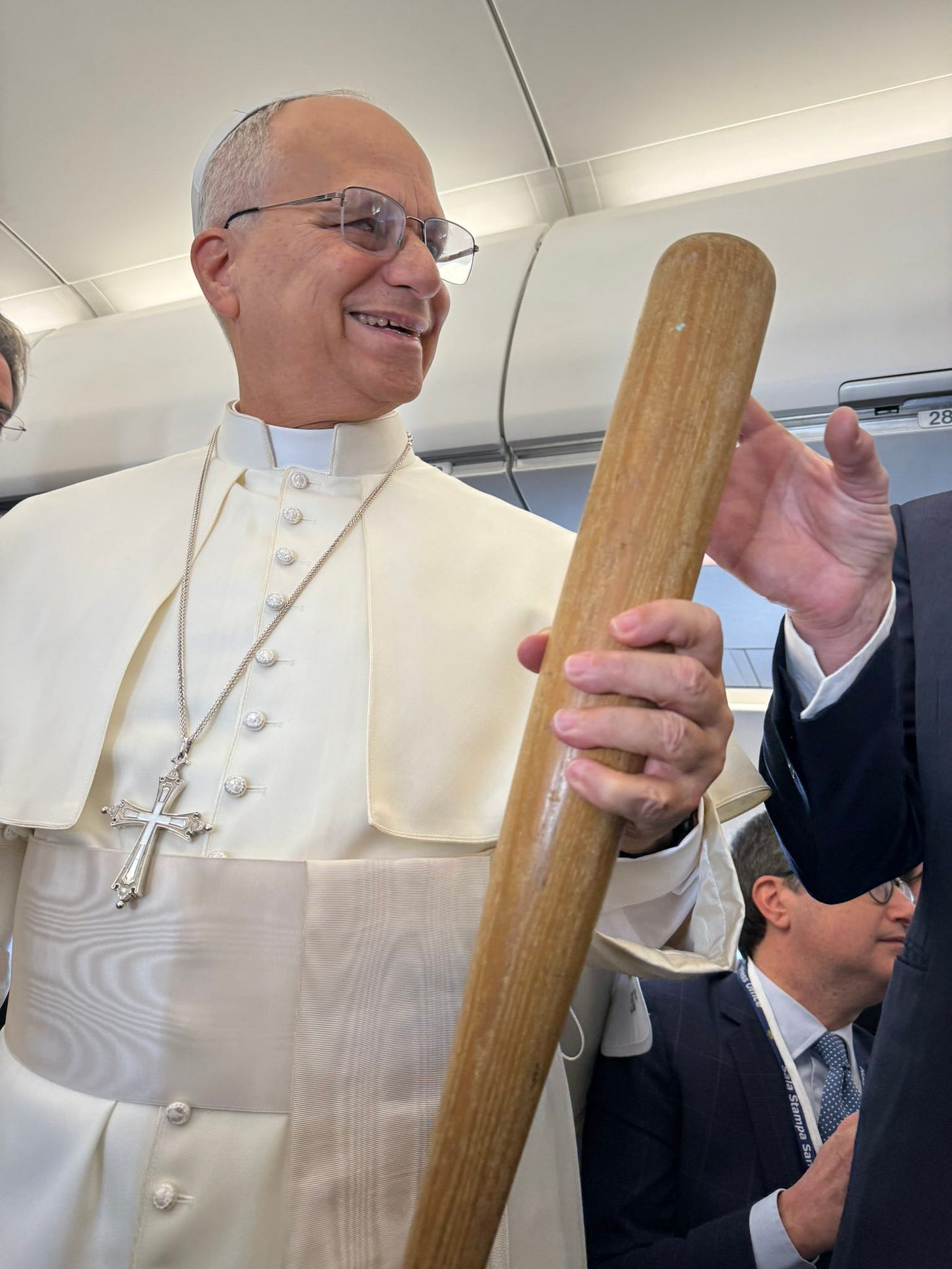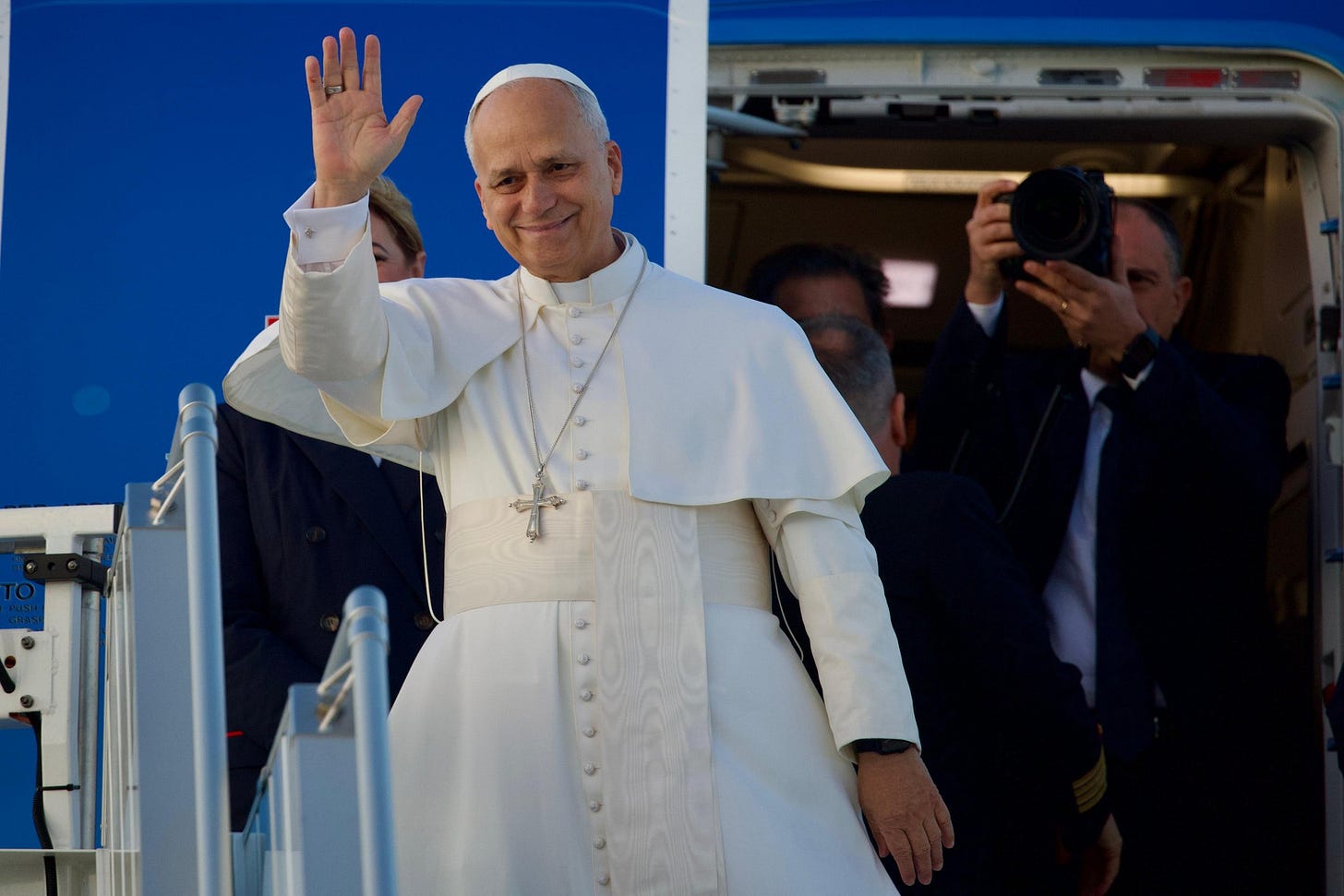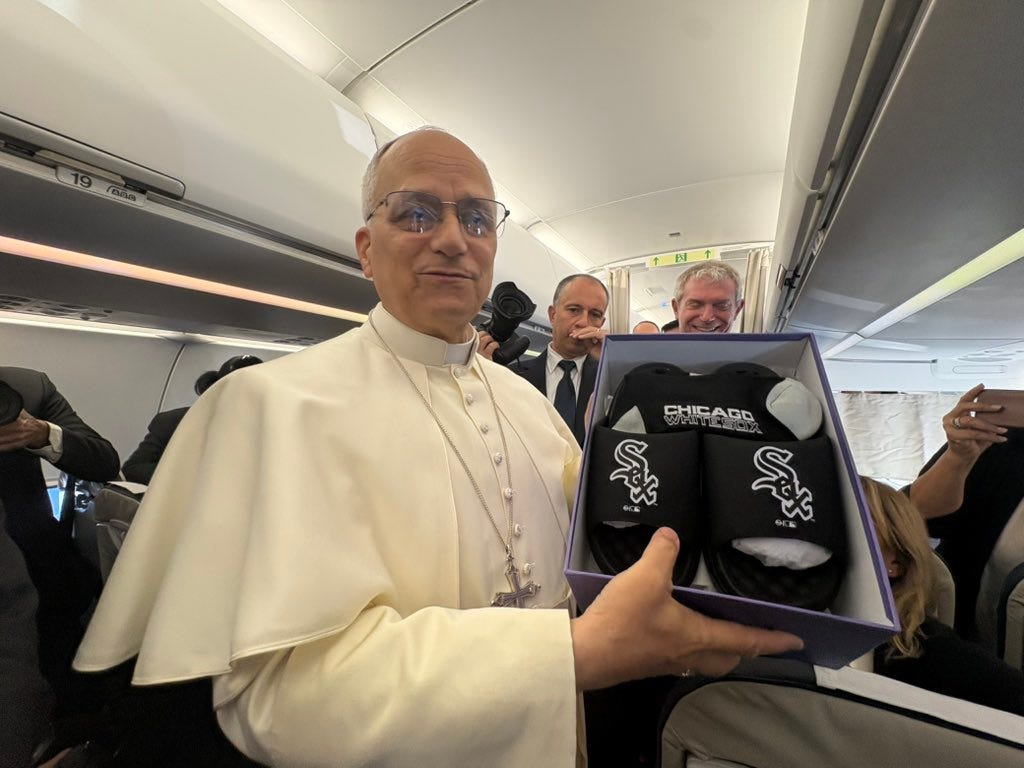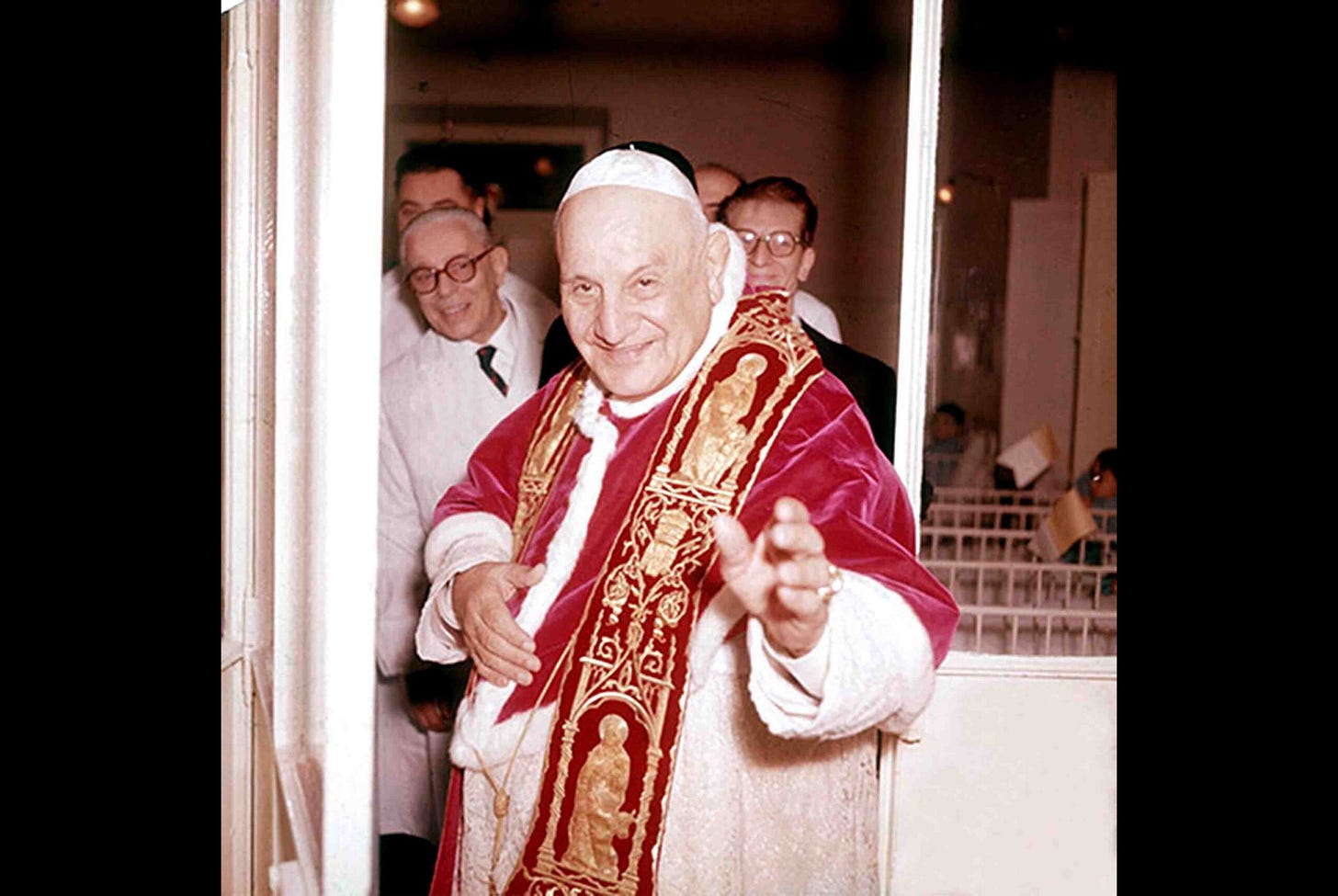American Pope Spends Thanksgiving in Turkey: Pope Leo Serves Pie — and a Challenge to ‘Might Is Right’
History’s first American pope spent Thanksgiving Day far from home — trading pumpkin pie banter at 30,000 feet for a profound plea to build bridges and shun brute power.
Thank you for reading! Letters from Leo is a reader-supported publication. If you find value in my work, please consider becoming a paid subscriber or making a one-time donation.
As a lifelong American Catholic, I’ve got to hand it to Pope Leo XIV: spending his first Thanksgiving as pope in Turkey might be one of the great Vatican trolls of all time.
The first U.S.-born pontiff literally spent Turkey Day in Türkiye. You can’t make this stuff up.
But beyond the cheeky coincidence, Leo’s first day abroad offered a telling mix of down-home American charm and high-octane moral leadership on the world stage.
Thanksgiving at 30,000 Feet

Pope Leo kicked off his maiden overseas trip by turning a routine papal flight into a flying Thanksgiving party. Keeping with tradition, Leo strolled down the aisle of the ITA Airways charter to personally greet the roughly 80 journalists accompanying him.
The Chicago-native pope was instantly in his element, trading jokes and accepting some very American tokens of affection.
CBS News correspondent Chris Livesay surprised Leo with a Louisville Slugger baseball bat that once belonged to Hall-of-Famer Nellie Fox — a Chicago White Sox legend whose heyday coincided with Leo’s own 1950s childhood.
The pontiff’s eyes lit up at the sight of the bat. “How did you get this through security?” he quipped with a grin, prompting hearty laughter from everyone around.
Leo, a devout White Sox fan, even received a pair of White Sox-branded slippers and socks as a gag gift — a playful nod to his recent joke that as pope he only wears “white socks.”
The camaraderie didn’t stop at baseball bats and slippers. American members of the press corps made sure the 70-year-old pope didn’t miss out on Thanksgiving treats: they handed him pumpkin and pecan pies right there on the plane.
Leo beamed at the sight of the desserts (there was more than enough to share) and wished the crew a joyous holiday. “
To the Americans here, Happy Thanksgiving!” he declared over the cabin mic, calling it “a wonderful day to celebrate.”
It was a warm, almost familial scene at 30,000 feet — a far cry from the stiff formalities that are a stereotype of pontifical activities decades past.
In between bites of pie and banter about turkey (in both senses of the word), Leo even found time to boast about his morning Wordle.
Despite the early wakeup, the pope proudly told reporters that he’d solved today’s puzzle in just three tries.
Leo and his brother text each other their Wordle scores daily – some sibling rivalry doesn’t stop just because one becomes pope.
Leo’s airborne Thanksgiving festivity wasn’t just for show. It underscored the kind of pope he is: informal, approachable, chummy with the media, and keenly aware of the moment.
In fact, today’s in-flight merriment followed on Leo’s own pre-trip message urging everyone — not only Americans — to make Thanksgiving a day of sincere gratitude.
Earlier this week, he encouraged people to “recognize that we all have received so many gifts… and to give thanks to God for the many gifts we’ve been given.”
And on the plane, between pie servings, Leo took a moment to thank the journalists for their work, stressing the need for reporting “that really reveals the truth and the harmony that the world needs.”
In true Leo style, the first American pope managed to turn a long-haul flight into both a holiday celebration and a mini catecheses on truth and gratitude.
Bridges over Power in Ankara

Once on the ground in Turkey’s capital, the tone shifted from festive to formal – but Leo’s core message remained consistent. Stepping off the plane just after noon, he received a full state welcome complete with a horseback honor guard escort to the Presidential Palace;
In a show of respect, Leo first paid homage to the country’s secular founder at Anıtkabir, the mausoleum of Mustafa Kemal Atatürk, a gesture that won him praise from local Turks who noted that some leaders skip the shrine for ideological reasons.
Then came the main event of Day 1: an address to Turkish authorities and the diplomatic corps alongside President Recep Tayyip Erdoğan. History’s first American pope stood in a Muslim-majority nation and delivered a remarkable speech about unity in diversity.
And in a fitting twist, Leo did so in English. Leo is the first English-speaking pontiff since Adrian IV in the 1150s, and he’s taking full advantage: during this trip he’s delivering all his speeches and homilies in English rather than the usual Italian.
Leo’s address in Ankara struck a theme of bridge-building — literally and figuratively.
He noted that Turkey’s geography and history make it a living bridge between continents and cultures.
Citing the newly built 1915 Çanakkale bridge over the Dardanelles Strait (which his team chose as the logo of this visit), Leo praised Turkey as a “crossroads of sensibilities” that derives strength from its internal diversity.
“Even before linking Asia with Europe, East with West, this bridge connects Türkiye to itself,” he observed, urging that uniformity would only impoverish a society so rich in culture.
Coming from a Christian leader in a land 99% Muslim, those words carried weight. Leo assured his hosts that Turkey’s tiny Christian minority “desire to contribute positively” as loyal citizens, and he held up one of his own heroes — St. John XXIII, who served in Turkey and was dubbed the “Turkish Pope” — as an example of Catholics embracing a national identity shared with Muslim neighbors.
The message was clear: the Catholic Church isn’t in Turkey to undermine unity, but to enrich it, hand-in-hand with all people of good will.
The moral climax of Leo’s speech came when he pointedly challenged a mindset of domination that he sees sowing chaos across the globe.
Standing next to President Erdoğan, Pope Leo declared that “justice and mercy challenge the mentality of ‘might is right,’ and dare to ask that compassion and solidarity be considered as the authentic criteria for development.”
In an age when brute force and zero-sum power plays often grab the mic, Leo flipped the script. He warned that our world is being destabilized by “ambitions and choices that trample on justice and peace,” citing the unusually high number of bloody conflicts raging right now.
“We must in no way give in to this,” he pleaded, because “the future of humanity is at stake.” Instead, Leo used his platform to elevate the virtues of mercy, dialogue and human fraternity.
Speaking in front of a giant globe at Ankara’s presidential library, he urged that “today, more than ever, we need people who will promote dialogue and practice it with firm will and patient resolve.
In short, build bridges, not arms races. On a day Americans associate with abundance and gratitude, Pope Leo took that spirit to a global stage – challenging leaders to abandon the shaky ethics of might-makes-right and embrace a more compassionate path.
It’s a striking contrast to so much of Western political discourse, which often glorifies raw power or nationalist grievance. Leo instead dared to suggest that true strength is found in solidarity — in recognizing every human being (of whatever faith or background) as a child of God worthy of dignity.
As Day 1 wrapped up, Pope Leo hardly had a moment to rest on his laurels (or his pumpkin pies). By evening he was wheels-up again, flying to Istanbul to begin the spiritual centerpiece of this journey.
Tomorrow, on the shores of the Bosphorus, Leo will join Ecumenical Patriarch Bartholomew to commemorate the 1,700th anniversary of the Council of Nicaea – literally and figuratively building bridges with the Orthodox Christian world. And for the first time in his pontificate, Leo will preside over a prayer servicein English, breaking with centuries of Latin and Italian to speak directly in the language he grew up with.
It’s just one more historic facet of a trip full of firsts. We’ll dig into the full text of Leo’s Ankara address in a forthcoming essay — there’s a lot to unpack in his vision of unity amid diversity — but even at first glance, his Thanksgiving Day debut abroad speaks volumes.
From pie-sharing in the press cabin to preaching mercy in the halls of power, Pope Leo XIV showed the world what Christian leadership can look like when it bridges worlds rather than divides them. On a day dedicated to gratitude, Leo gave us plenty to be thankful for.
Letters from Leo is open to anyone who wants to be informed and inspired by our pope — and to turn that inspiration into action that leaves America and the world more just, less cold, and more alive with hope.
If you want to support this mission this holiday season, here’s how you can help:
Subscribe as a paid member to receive exclusive posts about the life and formation of Pope Leo and help sustain this newsletter.
Donate with a one-time gift to fuel this project’s mission.
Share this post (and Letters from Leo) with a friend who might enjoy it.
Whether you give $0, $1, or $1,000, your presence here matters — no matter your faith or your politics.
Thank you for reading. I’ll see you on the road.







“CBS News correspondent Chris Livesay surprised Leo with a Louisville Slugger baseball bat that once belonged to Hall-of-Famer Nellie Fox — a Chicago White Sox legend whose heyday coincided with Leo’s own 1950s childhood.”
I remember Nellie Fox, Luis Aparicio, and Early Wynn. 😊
Karl Rahner’s idea of interfaith dialogue should be remembered here.
Rahner developed a theological framework that balanced fidelity to Christian conviction with respectful openness to religious difference.
His thought moved Catholic theology away from rigid exclusivism toward a constructive engagement with other faiths, arguing that genuine religious experience outside the visible Church can be an authentic site of God’s self-communication while still preserving Christian particularities.
Central to Rahner’s project is a philosophical-theological method that emphasizes human openness to the absolute. Drawing on transcendental currents in philosophy, he described human consciousness as fundamentally orientated toward God: an existential “openness” that makes every person potentially receptive to divine self-communication.
This “supernatural existential,” as Rahner called it, means that religions are culturally and historically mediated responses to a shared human orientation toward the absolute. From this perspective, non-Christian religious experience can possess real spiritual significance because it expresses humanity’s fundamental disposition toward the divine.
Rahner’s Christology and account of grace retain the Christian conviction that salvation is willed and achieved in and through Jesus Christ. Yet he reinterprets how Christ’s saving presence operates in history and across cultures.
Because God’s action does not conform to human boundaries, Rahner argued that non-Christians may be recipients of Christ’s saving gift even without explicit knowledge of or formal membership in the Christian Church. This insight led him to his most debated concept: the “anonymous Christian.” Rahner used the term to describe people who respond to God’s grace in faith, hope, and love—though they lack explicit Christian faith or baptism.
The notion aims to explain how God’s universal salvific will and Christ’s mediation might extend beyond the visible Church; it is not intended as a sociological label or as a denial of genuine religious difference.
To illuminate how anonymity relates to ecclesial fullness, Rahner appealed to the medieval notion of a votum—a longing or desire—for the Church.
Implicit dispositions toward the Church’s salvific reality, he suggested, can suffice to receive grace in God’s judgment. At the same time, Rahner insisted that such implicit reception is incomplete: explicit knowledge of and incorporation into the Church remain normatively significant for the fullness of Christian life.
Thus, his account preserves the Church’s normative role while acknowledging that God’s grace may operate beyond institutional boundaries.
Rahner’s theology provided Catholics with a robust warrant for respectful interreligious engagement.
By affirming a universal human openness to God, he made it theologically legitimate to treat adherents of other religions as genuine moral and spiritual agents rather than mere recipients of missionary correction.
This stance supported a vision of mission that was neither triumphalist nor indifferent: mission remains necessary because anonymous receptivity is fragmentary and incomplete, but it must be practiced with humility and respect for the genuine goods present in other traditions.
Rahner’s framework also encouraged theological learning and mutual enrichment, opening space for comparative theology and cooperative public work for justice and peace.
Still, Rahner’s proposals invited significant criticism and posed persistent tensions.
Some theologians worried that the anonymous-Christian thesis diluted the distinctiveness of the Gospel and weakened the necessity of explicit Christian faith, effectively rendering the Church optional.
Others argued that Rahner’s account introduced soteriological ambiguity by making salvation appear too broadly available without clear doctrinal or sacramental markers.
Additionally, critics observed that Rahner’s framework, despite its openness, remained essentially Christocentric: it recognized value in other religions chiefly insofar as they participated—whether explicitly or implicitly—in Christ’s grace, rather than treating them as theologically autonomous traditions in their own right. These debates have practical consequences in pastoral contexts, where Rahner’s nuanced distinctions can be misunderstood and require careful catechesis to avoid complacency about evangelization or cultural insensitivity.
Rahner’s influence, however, is undeniable. His thought resonated with the spirit of engagement that emerged in the Second Vatican Council and continues to inform contemporary Catholic approaches to Islam, Hinduism, Buddhism, and secular worldviews.
By framing other religions as potential loci of authentic response to God, Rahner offered Catholic theology resources for entering interreligious conversation without abandoning core convictions.
In pluralistic societies, his insistence on both the uniqueness of Christ and the real religious dignity of others has helped shape practices that combine faithful witness with genuine dialogue—interreligious meetings, shared ethical initiatives, and comparative theological projects that allow learning in both directions.
In the end, Karl Rahner supplied Catholic theology with a disciplined and philosophically informed account of how God’s grace might extend beyond visible Church structures while maintaining Christological priority. His notion of the “anonymous Christian” and his broader transcendental-anthropological method made interfaith dialogue theologically plausible and pastorally responsible for many Catholics.
Though his proposals continue to provoke critique—especially around questions of identity, soteriology, and the autonomy of other religions—Rahner’s work remains one of the most influential resources for negotiating the tension between fidelity and openness in interreligious engagement.